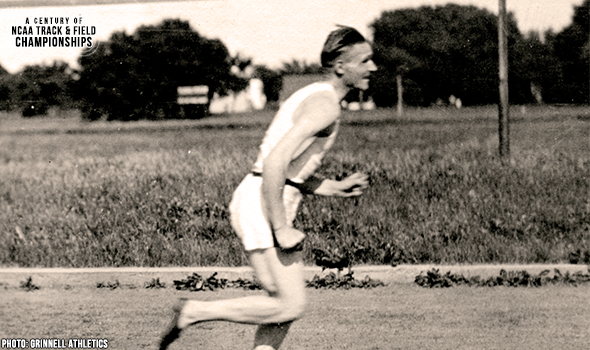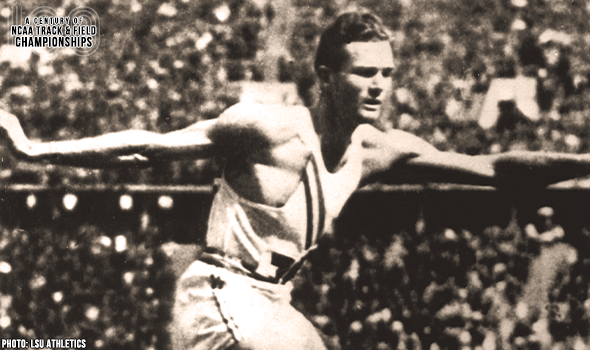
Same Athletes, Same Result For LSU At NCAAs
Winning both relays in the same NCAA Division I Outdoor Track & Field Championships had only been done twice by men’s programs before 2003 at Hornet Stadium in Sacramento, California.
LSU became the third with a unique twist – both squads were made up of the same four athletes. In fact, it has only happened one other time in meet history: Florida State’s women did the same in 1983.
The Tiger men didn’t enter the NCAA meet favored in either relay, but by the time of the first final – Friday’s 4×100 – LSU had broken 39 seconds for the first time with a nation-leading 38.84 in the heats. That was just inches ahead of SEC champ Tennessee’s 38.85.
In the final, LSU again had their best race all year as the foursome of Kelly Willie, Robert Parham, Pete Coley and Bennie Brazell improved to 38.65. Brazell held off UT’s Jonathan Wade on the homestretch as the Volunteers also ran a seasonal best of 38.72.
As is just about normal in the NCAA meet, the concluding track event on Saturday provided four laps of excitement. LSU had won the NCAA Indoor 4×400 crown in March, but outdoors had yet to better their 3:04.79 indoor time and was actually just the final qualifier for this final.
Baylor had the fastest seasonal best of the finalists at 3:02.82, but the fashionable pick was Minnesota. The Golden Gophers were led by Adam Steele and Mitch Potter, who earlier in the afternoon finished a surprising 1-3 in the 400.
At the first exchange, Minnesota’s Steele (45.8) handed off just behind Texas, which had the fastest split at 45.7. Robert Parham (who owned a 20.44 PR in the 200) kept LSU close with a 46.4 split as all eight teams were in contention.
Minnesota got a strong second leg from Andy Wohlin (45.9) to take the lead as Baylor was now in second. LSU moved into third with a 45.9 split by Brazell, who had finished fourth in 400 hurdles the previous day after his anchor duties on the 4×100.
LSU took the lead on the third leg after a 45.1 split from Coley, who showed some of his form from 2002 when he ran 44.89 and was third in the NCAA 400. Minnesota remained in second just ahead of fast-moving Texas Tech after a storming 44.5 split from Julian Raeborn.
The anchor legs were fast with a thrilling homestretch battle between the Gophers’ Potter and the Tigers’ Willie, who was fifth earlier in the 400. Willie never relinquished the lead, splitting 44.6 to hold off the 44.5 of Potter.
The squads from LSU (first in 3:02.01) and Minnesota (second in a school-record 3:02.33) recorded their best-ever finishes in the event.
The Tigers would see additional NCAA scoring from Brazell and Willie. Brazell was second in the 400 hurdles in 2004 and 2005, while Willie was runner-up in the 400 in 2004 and 200 in 2006. Both were staples on both relay teams, including a 2:59.59 in 2005 that was the collegiate record for 13 years.
Brazell, who was also a wide receiver on LSU’s 2003 national-champion football team, is now in his 10th year as an assistant coach on the Tiger track & field program.
The NCAA and collegiate track & field will mark a momentous milestone in the spring of 2021 -- the 100th anniversary of the NCAA Championships and with that, the NCAA Track & Field Championships. In June 1921, the University of Chicago hosted the first track & field championships in NCAA history.
This point can’t be emphasized enough: Not only was the event the first for NCAA track & field, but the first championships for any sport under the sponsorship of the NCAA.
To celebrate, over each of the next 365 days, the U.S. Track & Field and Cross Country Coaches Association (USTFCCCA) will celebrate moments, student-athletes, and coaches that have made a century’s worth of championships special. From humble beginnings to important historical milestones to the modern-day, collegiate track & field has evolved with the American society.
The 2021 edition of the NCAA Division I Outdoor Track & Field Championships begin with preliminary round action on May 27-29 in Jacksonville, Fla., and College Station, Texas. The championships final site and culmination of the celebration is slated for June 9-12, 2021 at the newly rebuilt Hayward Field in Eugene, Ore.

SIU’s Roggy Dominated The Javelin In 1978
Bob Roggy won the javelin title at the 1978 NCAA DI Outdoor T&F Championships by more than 20 feet. Roggy qualified first for the final with a MR heave of 89.30m (293‑0).

Makusha Made History In Bowerman Year Of 2011
Ngoni Makusha became just the fourth man in meet history to win individual titles in both the 100 and LJ. It was his 3rd career LJ crown and he set a CR in the 100 of 9.89.

George Mason’s Gage Shocked The NCAA LJ In 1988
Nena Gage won the long jump at the 1988 NCAA DI Outdoor T&F Championships in a shocking upset over Gail Devers.

Texas’ Thompson Marveled In NCAA Distance Events
Jerry Thompson won three career distance titles at the NCAA Outdoor T&F Championships. His first came in 1943. Then he won again in 1947 & 1948 after serving in World War II.

Grinnell’s Paulu Sprinted To NCAA History
Leonard Paulu was the first athlete to complete the 100-200 double in NCAA Outdoor Track & Field Championships history in 1922. That also made him the 1st to win back-to-back 100 titles, too.

Scott Won Back-To-Back NCAA Hammer Titles
Candice Scott won back-to-back hammer throw titles at the NCAA DI Outdoor T&F Championships in 2003 & 2004. Scott set a meet record of 69.77m (228-11) in that first year.

Drouin Soared To The Bowerman In 2013
Derek Drouin won two career HJ titles at the NCAA DI Outdoor T&F Championships. When Drouin won in 2013, he was only the fourth man to clear 2.34m (7-8) in meet history.

Watts Made Quick Work Of NCAA 400
Quincy Watts set a meet record in the 400 of 44.00 at the 1992 NCAA DI Outdoor Track & Field Championships. It lasted 25 years until 2017.

Iowa State’s Koll Rolled To 5K-10K Crowns
Lisa Koll won three career titles at the NCAA DI Outdoor T&F Championships in dominant fashion. Her average margin of victory in those 5K & 10K races was 37.73 seconds.

LSU’s Hardin Completed Unique 440-220H Double Twice
The nearly unheard of 440-220H double was so nice that Glenn Hardin did it twice! Hardin became the first to do so in meet history in 1933 and then swept them again in 1934.

